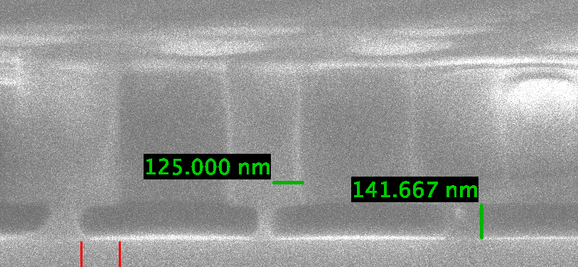Lift-Off with DUV Imaging + PMGI Underlayer
Developed by Demis D. John, ~2017-2019
This process is intended for Deep-UV Exposure on the ASML DUV Stepper. PMGI is used as the underlayer, which is exposed at the same time as the imaging resist.
Adjust spin speed or switch to a different PMGI formulation to tailor the underlayer thickness to your desired metal thickness.
Tips
Please see our Bi-Layer Lift-Off Tutorial to understand the limitations and requirements for good lift-off.
- Remember that gaps in between adjacent metal traces can lift-off during the develop!
- Need underlayer thickness approx. 2x the desired metal thickness.
- The underlayer will develop laterally from both sides which can lift-off the imaging resist, so:
- Minimum gap between adjacent metals should then be: greater than 0.5 * underlayer thickness
- Want at least 30-50nm of underlayer width left to support the imaging resist, so the PR doesn't fall over/collapse.
- Make sure to use a vertical evaporation line-of-sight such as EBeam4 or EBeam1. EBeam3 is not vertical unless special care is taken.
Process Limits
This process is written with PMGI SF-5 @ 4krpm, which spins to about 130nm
- Maximum metal thickness = 130nm/2 ≈ 65nm (can possibly increase up to 130nm* 2/3 ≈ 85nm)
- Undercuts laterally about 130-140nm, so minimum gap between metals = (2 x 140nm) + ~30nm ≈ 350nm
Adjust the PMGI layer thickness to adjust these process limits.
PMGI could be spun thicker, or double-spun to get thicker underlayers (develop time & undercut will increase accordingly).
PMGI underlayer could be replaced with LOL1000/LOL2000, or another developable underlayer.
Suggested Process for Liftoff
| De-H2O Bake (eg. 220°C, 1m+)
- or - Technics O2 ash (300mT, 100W), 15sec |
Oxygen ash is faster and more effective |
| Spin PMGI SF-5 @ 4krpm (rcp 7) | |
| POLOS underside clean: 2000rpm, ACE/ISO/N2 | |
| PMGI-Bake: 220°C, 3min (BrewerSci lift-pin hotplate). | Can just place wafer directly onto hotplate surface.
Optionally can use lift-pins & Recipe "00 220deg, 3min Vac"; --> To prevent wafer sliding: Enable Vacuum with overhead valve, only for wafer landing and then turn off. |
| Spin UV-6-0.8 @ rcp 6 (3.5krpm) | |
| POLOS underside clean: 2000rpm, ACE/ISO/N2 | |
| Soft-Bake = 135°C, 1min (builtin hotplate) | |
| (check underside for particulates) | |
| ASML Exposure | |
| Default: Exp = 37.5mJ // foc = –0.10 | Try this exposure dose but might need to do a FocArray (smaller Image Distribution eg. 5x5) to find proper exposure. |
| PEB = 135°C, 1.5min (built-in hotplate) | |
| Dev (300MiF) = 50sec (CRITICAL time) | Use cassette & H2O rinse dish prepared
--> not stirring, instead very slow/gentle lift/drop at various angles or gentle swish just to mix developer slightly. |
| DI rinse | Very Gently! Dunk into prepared DI dish, and dump/fill gently 2x. Don’t allow direct hard water to hit PR surface. |
| Dry - either low-pressure N2, or spin-dry | 4-inch wafers - use spin-dry on POLOS spinner. Small samples - use low-pressure (eg. 15psi) N2 gun. |
| PEii Technics O2: 30sec (100W/300mT) | May increase feature size openings by ~50nm. |
| Metal Evaporation
(insert steps) |
EBeam#4 or EBeam#1 with vertical/4-inch holders (not planetary) |
| Lift-off in NMP | Facing down or vertical.
Optional: going directly into continuous Ultrasonic can reduce residual particles. |
Data
• For PMGI Baked at 220°C for 3min, the PMGI dissolves in AZ 300MIF at a rate of approximately ~600nm/min.
Images / Examples
